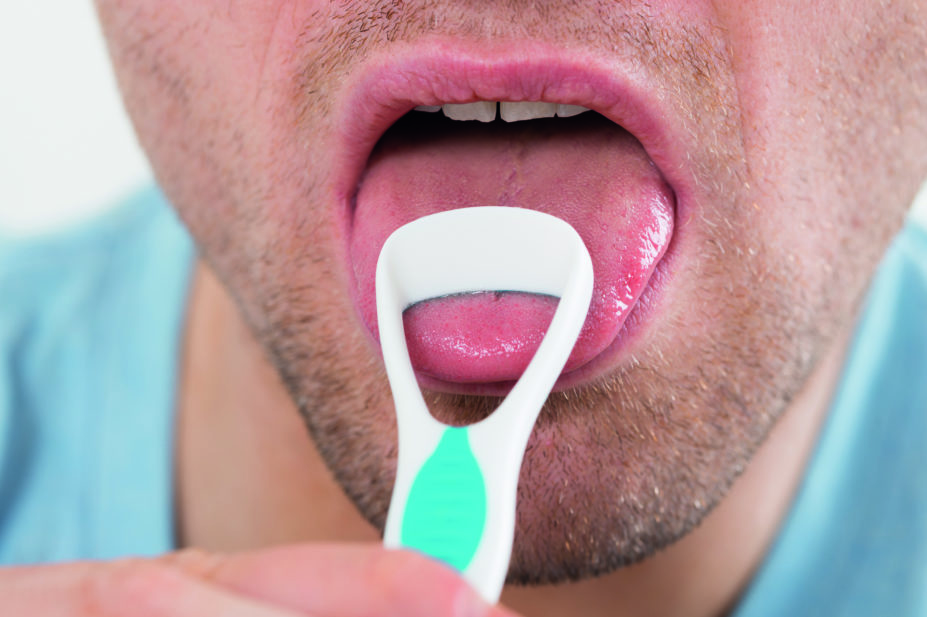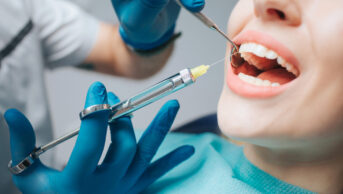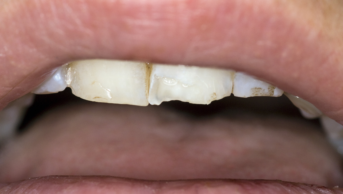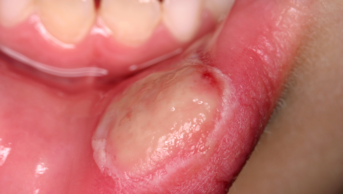
Shutterstock.com
Halitosis can be defined as having offensive breath odour[1]
. It is estimated to be the third most frequent reason for people to seek dental care, following tooth decay and gum disease[2]
. Halitosis is seen as one of the most unattractive aspects during social interaction, with the potential to cause considerable personal discomfort and social embarrassment[1]
.
There are no reliable data on the prevalence of halitosis in the UK, but it is a common problem in all age groups[3]
, with an estimated prevalence of between 15% and 50% of the adult population in non-UK studies[4]
.
In the majority of patients complaining of halitosis (<90%), the source of the offensive breath odour is intra-oral, typically an atypical tongue coating (around 50% of cases), periodontal conditions (gingivitis or periodontitis [<15% of cases]), or a combination of the two (<25% of cases). Temporary, or transient, halitosis can be caused by smoking and dietary factors such as garlic. In <5% of cases, halitosis may have an extra-oral source, often ear, nose and throat (ENT), gastroenterological, or bronchial and pulmonary pathologies. It can also be associated with systemic diseases (e.g. diabetes), metabolic or hormonal change and hepatic or renal insufficiency[5]
,[6]
,[7]
.
Pseudo-halitosis is the term for patient-perceived halitosis that is not apparent to either a dental professional, or any of the patient’s family, friends or close associates. Pseudo-halitosis is common, affecting <28% of patients attending halitosis clinics[8]
. Patients with pseudo-halitosis who, despite counselling, persist in the belief that they have breath odour are categorised as having halitophobia[6]
. It is often difficult for individuals to tell if they have halitosis, and individuals who notice the conditions in others are typically reluctant to tell them.
Aetiology
Between 80% and 90% of offensive breath odours of intra-oral origin can be attributed to volatile sulphur compounds (VSCs) – a product of the degradation of organic substances by oral anaerobic bacteria[1]
,[2]
,[3]
. These bacteria are commonly found in the coating located on the upper posterior surface of the tongue and may be associated with periodontal conditions.
Poorly maintained and ill-fitting dentures; open, debris-filled cavities in carious teeth; oral infections, including Candida infections; and draining abscesses may give rise to, or contribute to halitosis as further sources of VSCs[6]
. Patients may experience halitosis following oral surgery procedures, especially dental extractions, leaving teeth sockets in the mouth that may be difficult and painful to keep free of debris.
The following sections describe the areas where pharmacists, as accessible clinical and health professionals, can advise patients to promote oral health and to prevent and manage halitosis.
Dental care
Except for individuals with transient oral malodour, those seeking help to manage halitosis should, in addition to being advised to practice effective oral hygiene, be encouraged to seek dental help[9]
. A detailed dental examination, including the use of a standardised, halitosis questionnaire (e.g. Computerized ‘Anamnese’ International [CAI]), should identify the cause of the halitosis.
If the source of halitosis is found to be extra-oral[9]
, the dentist will be best placed to make any necessary referral, possibly leading to shared care of the patient with, for example an ENT specialist. Consensus guidelines on the management of halitosis by general dental practitioners were published in 2014[10]
.
Effective oral hygiene
The key elements of effective oral hygiene are outlined in Box 1.
Box 1: Key elements of effective oral hygiene[10]
- Brush at least twice daily, with a fluoridated toothpaste;
- Brush last thing at night and at least on one other occasion;
- Use fluoridated toothpaste with at least 1,350ppm fluoride;
- Spit out after brushing and do not rinse, to maintain fluoride concentration;
- The frequency and amount of sugary food and drinks should be reduced.
Toothbrushes
A small-headed toothbrush with medium texture bristles should be recommended. There is evidence that powered toothbrushes can be more effective than manual toothbrushes, but what is most important, whatever toothbrush is used, is that each time the teeth are brushed it is for at least two minutes, and that all tooth surfaces are cleaned. No tooth-brushing technique has been shown to be better than another; however, most people’s existing method of brushing will benefit from modification under dental guidance. Disclosing tablets help identify teeth and tooth surfaces that are being missed[10]
.
Interdental cleaning
Cleaning between the teeth should be carried out at least once a day. Dental floss or tape should be used to clean small interdental spaces. All other interdental spaces should be cleaned using interdental brushes. Guidance on which type and size of interdental brush to use is best provided as part of routine dental care[10]
.
Tongue cleaning
Mechanical tongue cleaning (tongue scraping), as an integral element of the daily oral hygiene regimen, can be regarded as a basic therapeutic and preventive measure for intra-oral halitosis[11]
. Tongue cleaning should be carried out using a tongue scraper applied gently with low force. Mechanical cleaning of the tongue with a regular toothbrush can be injurious, possibly causing micro-bleeding, together with various forms of damage to the surface of the tongue. The use of a power (electric) toothbrush to clean the tongue can cause marked damage to the surface of the tongue, possibly resulting in ulceration and pain.

Source: Eye of Science / Science Photo Library
Tongue cleaning should be carried out using a tongue scraper applied gently with low force. The image, a micrograph, shows a human tongue surface with bacteria, a common causative agent of halitosis.
Mouth rinses
In addition to tongue scraping, the use of mouth rinses has been advocated as an adjunct to routine, at least twice a day brushing and associated cleaning of the teeth and gums[1]
,[10]
. A wide range of mouth rinses containing antibacterial compounds, notably zinc ions, chlorhexidine and cetylpyridinium chloride, have been shown to be effective in reducing oral malodour[1]
. In all cases, self-prescribed/over-the-counter purchased mouth rinse should be used in accordance with manufacturer’s directions.
Mouth fresheners
The use of mouth fresheners (‘deodorisers’), which come in many different forms and flavours at best only mask oral malodour; they have very little, if any effect on the underlying cause of halitosis. While popular for masking transient oral malodour, for example, the morning after consuming a lot of garlic, the effectiveness of mouth fresheners in such situations is limited, given that the odorous gases, giving rise to the transient halitosis, are exhaled, having entered the lungs from the bloodstream (transient blood-borne halitosis).
Chewing gum
Chewing sugar-free gum may help to remove food debris from around the teeth and stimulate saliva production[10]
. These two effects can help reduce halitosis, especially if the gum has a strong flavour. However, as with mouth fresheners, the use of chewing gum does not address the underlying cause of halitosis.
Dehydration
The mouth may be dry first thing in the morning, giving rise to morning bad breath, often caused by mouth breathing while asleep.
Individuals who fail to drink the recommended volume of water and other fluids (at least six to eight glasses daily) and thus tend to suffer dry mouth, with the associated increased risk of halitosis, may be inclined, together with smokers and sufferers of transient halitosis, to rely on chewing gum to keep their mouth moist and fresh. Providing advice on how to avoid dehydration can have many benefits over and above those of helping to control halitosis.
Collaboration
Intra-oral halitosis is initially best managed by effective oral hygiene, including tongue- and interdental cleaning, with the adjunctive use of a mouth rinse containing an antibacterial compound. Dental care should be advised to diagnose, treat the underlying cause of the halitosis, and hopefully prevent recurrence. It is, therefore, important for dentists and pharmacists to develop interprofessional working, (e.g. by cross-referring patients) in the best interests of patients[12]
.
Reading this article counts towards your CPD
You can use the following forms to record your learning and action points from this article from Pharmaceutical Journal Publications.
Your CPD module results are stored against your account here at The Pharmaceutical Journal. You must be registered and logged into the site to do this. To review your module results, go to the ‘My Account’ tab and then ‘My CPD’.
Any training, learning or development activities that you undertake for CPD can also be recorded as evidence as part of your RPS Faculty practice-based portfolio when preparing for Faculty membership. To start your RPS Faculty journey today, access the portfolio and tools at www.rpharms.com/Faculty
If your learning was planned in advance, please click:
If your learning was spontaneous, please click:
References
[1] Winkel EG, Halitosis control. In: Clinical Periodontology and Implant Dentistry, Vol 2, Fifth Ed. Eds., Lindhe J, Lang NP & Karring T, ISBN: 978-1-4051-6099-5, Blackwell Munksgaard, 2008, pp 1325–1340.
[2] Loesche WJ & Kazor C. Microbiology and treatment of halitosis. Periodontol 2000;28:256–279. doi: 10.1034/j.1600-0757.2002.280111.x
[3] Scully C & Greenman J. Halitology (breath odour: aetiopathogenesis and management). Oral Dis 2012;18:333–345. doi: 10.1111/j.1601-0825.2011.01890.x
[4] van den Broek AM, Feenstra L & de Baat C. A review of the current literature on the aetiology and measurement methods of halitosis. J Dent 2007;35:627–635. doi: 10.1016/j.jdent.2007.04.009
[5] Yaegaki K & Coil JM. Examination, classification and treatment of halitosis: clinical perspectives. J Can Dent Assoc 2000;66:257–261. PMID: 10833869
[6] Rosenberg M. Clinical assessment of bad breath: current concepts. J Amer Dent Assoc 1996;127:475–482. doi: 10.14219/jada.archive.1996.0239
[7] Tangerman A & Winkel EG. Extra-oral halitosis: an overview. J Breath Res 2010; 4(1):017003. doi: 10.1088/1752-7155/4/1/017003
[8] National Institute for Health and Clinical Excellence (NICE). Clinical Knowledge Summaries: Halitosis. Available at: https://cks.nice.org.uk/halitosis (accessed April 2017)
[9] Seemann R, Conceicao MD, Filppi A et al. Halitosis management by the general dental practitioner – results of an international consensus workshop. J Breath Res 2014;8(1):017101. doi: 10.1088/1752-7155/8/1/017101
[10] Public Health England. Delivering better oral health: an evidence-based toolkit for prevention. Available at: https://www.gov.uk/government/publications/delivering-better-oral-health-an-evidence-based-toolkit-for-prevention (accessed April 2017)
[11] Beekmans DG, Slot DE & Van der Weijden GA. User perception on various designs of tongue scrapers. Int J Dent Hygiene 2016. doi: 10.1111/idh.12204
[12] Wilson NHF & Soni A. Interprofessional working: a spearhead opportunity for dentistry and pharmacy. Br Dent J 2016;221:607–608. doi: 10.1038/sj.bdj.2016.853


